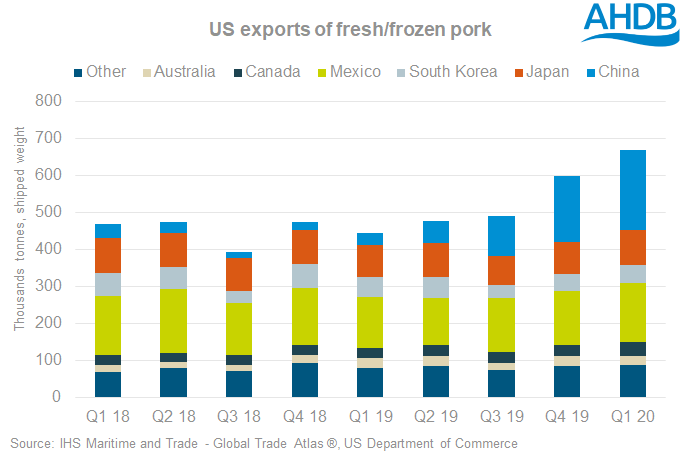The US and Canada have seen a strong start to pork exports for the year in both volumes and prices, according to the latest numbers reported by AHDB.
US exports of fresh and frozen pork amounted to 668,000 tonnes in the first quarter of 2020, a year on year increase of 50%. Trade was dominated by China, which increased its imports of US pork by nearly 600%, to over 216,000 tonnes, accounting for nearly a third of US exports. Exports to Mexico, Japan and Canada saw modest increases whilst volumes to South Korea fell slightly.
One of the biggest developments in US-China trading has come in the wake of ASF, as China found itself with excess processing capacity, and has increased the volume of carcases it buys. The US sent 99,500 tonnes of frozen carcases in the first quarter, having sent none a year ago.
Prices achieved by US exporters increased by nearly 11% to $2.65/kg. Prices to China increased by 67% to $2.46/kg.

Canada’s export performance in the first quarter saw improvement, with volumes increasing y 16% to 290,000 tonnes, again underpinned by trade to Asian countries, in particular the continued strength of the Chinese market. China imported 124,000 tonnes of Canadian pork in the first quarter, up 53% year on year, and Japan imported 57,000 tonnes, up 10%. Volumes to South Korea fell by 28% to 6,900.
Duncan Wyatt, lead analyst at AHDB said that whilst North American exports have risen these figures pre-date the processing capacity issues caused by outbreaks of coronavirus in important meatpacking plants in the US.
He said: “Pork production has been cut dramatically, and the positive start that 2020 had in production, was severely derailed in April and May. However, most if not all processors in the US appear to be operating again now although perhaps at reduced capacity. Unfortunately, some lost production will not be regained, and there could be an oversupply of live pigs for some time to come. Sow slaughter has been elevated too in recent weeks, and this can be expected to curtail production growth in the medium term.”




